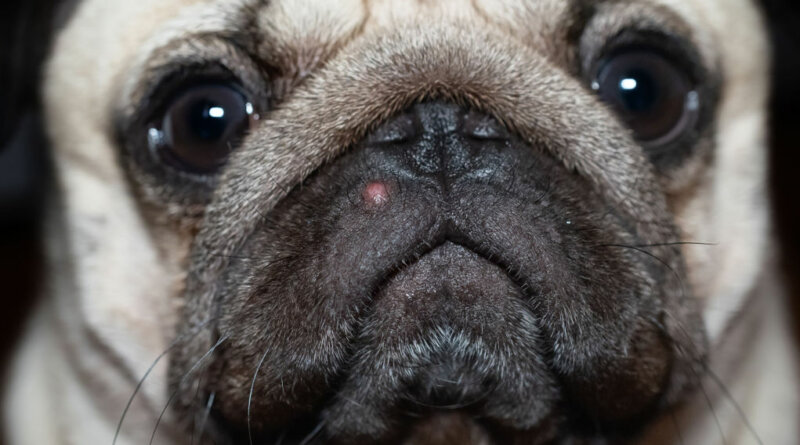Symptoms, Causes, and Treatment – Top Dog Tips
Similar to humans, dogs’ skin can experience breakouts from clogged hair follicles, dead skin cells, or an undue amount of sebum in the skin.
Dogs can also have acne. This condition can range from lenient to severe cases and may even be just a symptom of other health conditions.
In this blog, we’ll discuss everything about acne in dogs—from its causes to its proper treatment.
If you’re a dog owner, it’s great of you to research these kinds of medical problems. It shows that you love and care about your pup.
But before we tackle all of those things, let’s first tackle what is dog acne.
Dog Acne: What Is IT?
Dog acne is the inflammation of the skin, usually in the areas on the lips and around the muzzle, which creates pinkish-to-red bumps or pustules in these regions.
It can also be an indication of other underlying skin conditions or diseases.
Folliculitis is one of the known acne in dogs. Folliculitis is the inflammation of the hair follicles.
The hair follicle is damaged by the accumulation of bacteria leading to inflammation and breakouts.
Folliculitis can be caused by numerous cases. Commonly it can be from skin trauma, bacteria, infections, and parasite.
In more atypical cases would be underlying conditions such as endocrine diseases (Cushing’s Disease, Pododermatitis, etc.,), immune system diseases (Hypothyroidism), and other more.
Furunculosis then is the ruptured hair follicle due to its congested pore with pus or infected follicles.
Both conditions can be acne. Acne can be painful and mostly itchy.
Dogs with acne should seek out their veterinarian for further analysis and treatment.
Undergoing proper treatment can help rehabilitate the skin to avoid acne or other skin conditions in the future.
Unfortunately, dog acne can occur in every dog breed but some breeds have it worst.
Dog breeds with short hair and folded skins Boxer, Doberman Pinschers, English Bulldogs, German Shorthaired Pointers, Great Danes, Mastiffs, Rottweilers, and Weimaraners.
Symptoms
On the other hand, let’s discuss the symptoms of acne in dogs.
As dog owners, we must monitor our pets and be aware of these symptoms to know if it is dog acne or another medical problem.
- Red bumps
- Pustules
- Inflammed skin around the area
- Hairless Papules
- Swelling
- Itching
Progressive Symptoms:
- Large Papules
- Ulcerated Acne without pus
- Discharge in Acne
- Extreme discomfort
- Excessive itching
- Pain
Dog acne can accumulate in different sites in a dog’s body.
The most common place it may accumulate would be its chin, muzzle, nape, stomach, and skin folds.
Causes of Acne in Dogs
The cause of dog acne is still undisclosed in research. However, there common
Allergies
Allergies can be one of the causes of acne.
When a dog repeatedly rubs their skin surface in an area, it may cause it to be damaged along with the hair follicles and pores.
This may lead to irritation and may compromise the pore to exposure in bacteria.
Autoimmune Disease
Some diseases may deteriorate the normal function of organs and glands.
Thus, it can create chemical imbalances in the body. Acne can become a result of some.
Demodicosis
Demodicosis is the infestation of face mites in the skin. For dogs, the areas on the face are mostly affected.
Demodex can lead to different damage skin conditions from scaling of the skin to papules, pustules, and hair loss
Dermatophytosis
Dermatophytosis is a fungus that affects a dog’s skin and can spread throughout the body.
This condition is contagious to both dogs and humans. Dermatophytosis has a symptom of acne-like bumps on the skin.
Genetics
Sadly, some dogs are prone to acne due to their genetics. Especially for dogs with skin fold characteristics, their skin is more accessible for acne.
It’s the same with dogs with short-haired coats. Some short-haired breed dogs have a genetic disposition in affirming excessive follicular keratinization.
Secondary Bacterial Infection
When a disease is contagious, similar to ringworm or staphylococcus pseudintermedius, it can create the same symptom in the skin.
After exposure to the bacteria, the skin gets infected and symptoms arise. This can happen especially when the skin has lesions.
Due to lesions, the area may accumulate bacteria and may take longer to recover.
Skin Trauma
The most common cause of dog acne is skin trauma. Skin trauma may often leave the affected area open for quite some time.
When the area is open it may lead to inflammation in the skin. Inflammation in the region may result in the area to decline in recovery and regress to skin infections or diseases.
Acne can be diagnosed in different methods depending on the veterinarian’s observation.
The veterinarian may try a method that is according to what they have observed.
Here are some methods the dog may undergo for diagnosing acne:
Physical Examination
Veterinarians may diagnose the condition by doing a physical examination.
Observing closer to the dog’s skin in the affected area, veterinarians may diagnose it from its physical characteristics.
If the veterinarian suspects any other condition, they may suggest and perform another method to further inspect the condition.
Bacterial-Fungal Culture
Veterinarians may perform bacterial-fungal culturing to identify what kind of bacteria or fungi is inhabiting the said pore.
Veterinarians will perform this method to further take note of what proper medication or treatment would best fit to eliminate the bacteria or fungi.
Biopsy
Veterinarians may perform a biopsy to inspect if there are any other possible skin conditions present aside from acne since it can be a symptom of other diseases.
The veterinarian may inquire with the owner about any other symptoms alongside the acne to rule out possible diseases.
Skin Scrapping
If owners observe acne symptoms in their dogs, it’s best to seek professional help rather than have them recover at home. Acne causes vary along with their form of treatment.
If medication or treatment is misused, it can either help reduce the symptom or worsen the condition.
Treatment for Acne in Dogs
Acne treatment may vary depending on the prescription of a veterinarian. Acne may get treated according to its cause.
Here are some common medications used by veterinarians in treating acne:
Aloe Vera
Aloe vera has a natural healing and anti-inflammatory function. This can help reduce the redness and irritation of the acne.
Shampoos or creams with aloe veras can be used.
Antibiotic/ Antifungal
If the acne is due to bacterial infection, the veterinarian will administer oral antibiotics to reduce bacterial infection and spread.
Antibiotics like Mucirin can be used while antifungals like Canison can be used.
Benzoyl Peroxide
Benzoyl Peroxide is a constituent that is used to remove acne. It helps unclog pores, remove dead skin cells and eliminate bacteria.
Topical Benzoyl Peroxide can be given to dogs to remove milder cases of acne.
Steroids
Steroids, also known as corticosteroids, are inflammatory agents that help reduce swelling and redness in conditions.
Oral steroids can help reduce inflammation in acne.
Dog acne reoccurrence may happen, depending on the origin and severity.
Owners may continue consulting the condition with the veterinarian to inquire about the proper treatment and prevention.
Prevention for Acne in Dogs
Preventing dog acne may be difficult if the cause is not ruled out. A simple way to prevent this is to keep your dog’s hygiene at its best.
Groom the dog as needed and after outdoor activities.
Remember to pat dry the dog after a bath. One of the leading causes of dog to have acne is bacteria accumulating in skin folds.
This can help avoid any heat and moisture getting stuck in the suppressed regions of the skin.
Wipe away any grime from the dog’s muzzle after a meal or if there is dirt present.
Owners can also check out the food their dogs are consuming. Allergies can develop acne.
Owners can check with their veterinarians regarding the food their dog is safe or not safe to eat.
Prevention can also be done by addressing the condition immediately.
If acne seems like it will spread or suppurate, it’s best to have it checked and treated immediately before it worsens or before it spreads.
Keeping the surroundings and means of the dog clean can also prevent the accumulation of dirt and bacteria from your dog.
Some dogs may brush their muzzle or skin against the surface of a wall or maybe their bowl.
If the item or surface is not clean, bacteria or fungi may reside in the item and on the dog’s skin.
Frequently Asked Questions
Is dog acne contagious?
Dog acne is not contagious to humans but you may get secondary bacteria infections from prolonged exposure.
Canine acne is not contagious to other dogs but they may also get secondary infections ling ringworm and sarcoptic mange.
Will dog acne go away on its own?
Depending on the cause of the acne, acne from puberty may go away. Acne from puberty is said to subside on its own.
Some acne can subside on its own but medication can help decrease their symptoms faster.
Should I pop my dog’s acne?
It’s best to leave the dog’s acne with the prescribed medicine and treatment procedures.
Plucking or popping the acne may risk the pore being exposed to other bacterial or fungal infections.
Dog Acne: Symptoms, Causes, and Treatment—Summary
Dog acne may be a skin condition your dog is currently experiencing but no worries, treatment and maintenance are available.
Acne should be addressed immediately by a professional. Home remedies may produce temporary results and may worsen the condition.
Owners should get a proper diagnosis and prescription to address the condition.
RELATED: COCONUT OIL ON DOGS SKIN: HOW TO APPLY AND CURE SKIN PROBLEMS (BASED ON STUDIES)
Related








